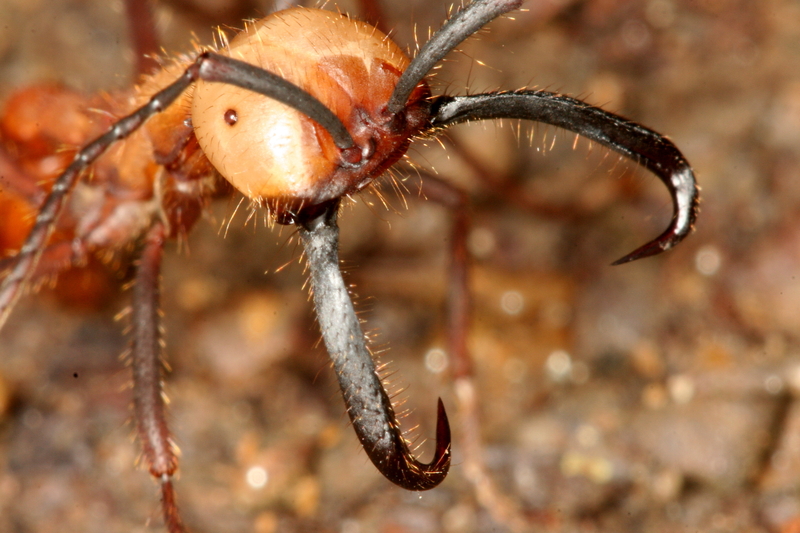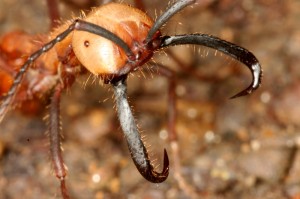
Updated Jun 2022
Tourists who go to Central America usually want to see the birds, monkeys, and perhaps a crocodile. I like those animals also, but I was looking for something that most tourists don’t – ants! Ever since I was a child, I had heard about swarms of army ants on the march, attacking and devouring anything in its path. So I went to Central America to see them for myself.
On the March
Most ants live in permanent nests, sometimes called an “ant castle”. But army ants are homeless and nomadic. There are many different species of army ants. They can be found in tropical rainforests throughout the world.
When army ants are on the march, a swarm of millions of them can cover an area up to 20 metres wide and 100 metres long. (A metre is three inches longer than a yard). I did not see any that big, but I saw some that were several metres across and about ten metres in length.
Army ants wander and are leaderless. The colony walks until they find some prey and devour it before moving on. A colony will consume up to 500,000 prey in a day, primarily insects. They not only kill things that fail to get out of their way, but they also pursue prey. I saw some army ants chasing a huge spider. They actively chased the spider and changed direction when it did. Although the spider could run faster, it was not smart enough to run a long distance to escape them. It would run a while and then stop, thinking it was safe. But the ants eventually caught up. Inevitably, some of the ants would tackle the spider. The spider would kill the first few ants that attacked it, giving the other ants time to surround it. Soon the spider was utterly overwhelmed and torn to shreds, and consumed. I have often seen ants and other insects caught in a spider web, so it was fascinating to observe ants hunting a spider.
Very Aggressive
Army ants are incredibly aggressive and will attack animals as large as a scorpion or a frog, or even small mammals. They would probably consume a whole human if the person did not try to get away. Fortunately, we are strong enough to escape their grasp. However, I have seen people stumble into their path or not notice their approach while looking up at the birds. I always wear good strong hiking boots or at least runners when I go hiking, but I have seen many people go in open-toed shoes or flip-flops. Although the ants cannot kill you, your feet and legs could be covered with many nasty bites.
Army Ants have huge mandibles, and they don’t simply bite their prey and kill it; they rip it apart. They have been known to attack prey such as mice or even snakes. Anything that does not have enough strength and speed to get away is doomed.
Bivouac
At dusk, the ants will stop for the night. Then, like soldiers on a route-march, they make a temporary bivouac. The camp could be in a dead tree or underground.
If no suitable location is found, they can make a living nest out of their own bodies. They cling to the ant in front of them and make a temporary shelter complete with walls and tunnels. Inside, the queen and the larvae are safe from predators.
Classes of Army Ants
Within the colony, there are three different types of army ants. The vast majority are female workers. One will be the queen. Sometimes males are hatched. The males soon fly away, searching for a queen bride and do not stay with the colony. If they meet a suitable partner, they will mate and start a new colony. Males soon die after mating. The queen can live up to 20 years. The workers live one year.
The Queen
Occasionally the colony will remain in one location for about 20 days to allow time for the queen to lay eggs and for the larvae to hatch. The queen might lay three to four million eggs during this time. The workers go out on hunting trips and return each night to the camp. When the new ants can travel, the colony will be on the march once again. The total population of the colony will number in the millions.
When the queen dies, the colony will die within a year if it does not acquire a new queen. The ants may merge with another colony. Or one of the newly-hatched ants might be a queen. If there is more than one queen, the colony will split as there can be only one queen per colony.
Antbirds
There is a family of birds called antbirds. These birds follow along with the marching ants and pick off the insects that flee to the left and right of the ant swarm. So it is an excellent opportunity for bird watchers to see some of these birds close up. But while watching the birds, you have to be mindful of the ants. They move faster than you might expect, and if you are not paying attention, they will soon be all over your feet and going up your pant legs.
Army Ant Movie
Lost Army Ants
What happens when some of the Army Ants get lost?
Click herehttps://mythatchedhut.com/lost-army-ants/ to find out.
